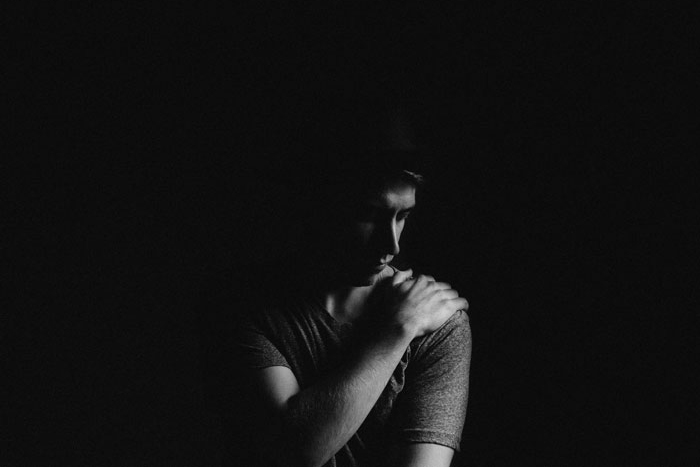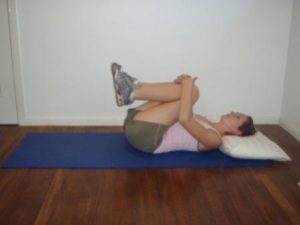
09 Jan Acute Pain
Always consult your Osteopath or General Physician before attempting an exercise or rehabilitation programme. For more information or to make an appointment please contact (07) 5607 0100 or click here to contact us by email.
POSITIONS TO EASE PAIN
Lying Over a Swiss Ball
This position is good for taking the pressure of the spinal discs.
Start lying on ball with feet wide for balance. Slowly roll forward until the ball is placed in front of your hips. Allow your body to bend forward rounding to the shape of the ball.
Relax your upper body completely and place your hands on the floor for support and balance. You should feel light to moderate stretching in the lower back and possibly hamstrings.
Astronaut
This position is also good for taking the pressure of your lumbar spine.
Lie flat on your back, with your legs supported by the ball.
Child Pose
This position is good for gently stretching the spine.
Kneel with your knees and ankles close together. Then gently fold forward with your arms resting by your side
Relieving Back Pain with Pillows
Many back patients discover that they are most comfortable lying on their side with their knees bent and their hips flexed. A pillow placed between the knees in this position will relieve an uncomfortable pull on the pelvis and hip. Very often, simply lying on your side and pulling your knees up toward your chest will ease back pain and relieve pressure on spinal nerves.
When you lie on your back, it is usually best to place a pillow under your knees so that your knees and hips are slightly flexed. This produces a little pelvic tilt that allows the lumbar spine to rest in a flattened, relaxed position.
Lying on your back with your legs flat on the mattress stretches hip flexor muscles, which in turn pull on the lower lumbar vertebrae. This pull can be very uncomfortable when the lower spine has been injured.
Exercise & Acute Pain
Using gentle stretching even when pain is severe, is a helpful way to reduce muscle tension and spasm, and if done correctly, is entirely safe. You may find that during a severe flare up, using either medication and heat makes it easier to stretch and get moving again.
Gradually increase your activities over a few days or up to a week. If an activity causes increased pain for the rest of the day, do less of the activity or find a substitute.
Do not stay in bed or frozen in one position. Movement, even if uncomfortable, can help you get through a flare up quickly. You can start by walking within your home. Try walking for a few minutes every hour. You can progress by taking walks outside on level ground. Walking often for a few minutes each time will likely be easier than walking only occasionally for a long time. You can slowly extend the number of minutes you walk each time, but at a rate that will get you back to normal levels of activity within a week. The key to being able to increase activities is to be consistent in what you do every day.
Pace yourself and use common sense. Give yourself permission to take it easy for a few days until the worst pain recedes. Pushing through severe pain might trigger a second relapse. On the other hand, doing too little may lead to a longer bout of pain.
Pacing yourself means finding out how much of an activity you can tolerate, and then performing that much on a consistent basis. It means stopping when you are approaching your tolerance level, not after you have exceeded it.
Knee Hugging
Knee hugging is an extremely useful exercise to try when you have sustained a recent back strain and your movements are painful and restricted. If you have been resting in bed because of back pain, do this exercise regularly, especially before you try to get up, as it will provide a good stretch for your lower back muscles and will prepare them for the increased effort required in rising
- One knee to chest
Now bring your left knee up to your chest and grasp it with your hands. Slowly pull your leg towards your chest as far as you can with out discomfort; hold for five seconds. Then slowly lower it to the starting position. Repeat with your right leg.
- Both knees to chest
Now repeat hugging both knees to your chest. Hold for ten seconds. Feel your lower back gently stretching and lengthening. Remember to breath! You may repeat this sequence twice more.
Leg rolling
This exercise gently stretches your lower back muscles and, providing it is done slowly and gradually, is very useful when your back muscles are tight and painful. However, do not attempt it if you have any pain or altered sensations in your legs or feet. It is important that you do not force the roll, stopping as soon as you feel a stretch in your back muscles. Stop immediately if you feel any pain.
Flat on back
- Lie on your back and stretch your arms out to the sides. Keep your shoulders flat on the ground and bend you knees, keeping your feet on the ground and knees together. Now tilt your pelvis correctly and tense your abdominal muscles.
- Slowly roll your knees to the left, feeling the stretch spreading up from your hips and into the muscles of your lower back. Keep your shoulders flat on the ground. Allow your knees to roll as far as you find comfortable and, once you have reached that point, try to relax into the stretch while holding your abdominal muscle tense. Hold for five seconds, remembering to breathe throughout the exercise. Slowly bring your knees back to the starting position and repeat the roll to the right. You may repeat the sequence twice more.
Pelvic Clock
Lie flat on the floor with your knees bent and feet flat on the floor
Gently rotate your pelvis upwards, downwards and then to either side without moving your legs and with minimal movement of your lower spine.
When getting up from lying on your back ALWAYS roll onto your side first then push up. This will decrease the strain on the lower spine and decrease the chance of reflex muscle spasms.
It is important that once the acute episode of pain has diminished you speak with your Osteopath so that a regimen of stretching and stability training can commence to further diminish the pain and decrease the chance of the pain/injury returning.








